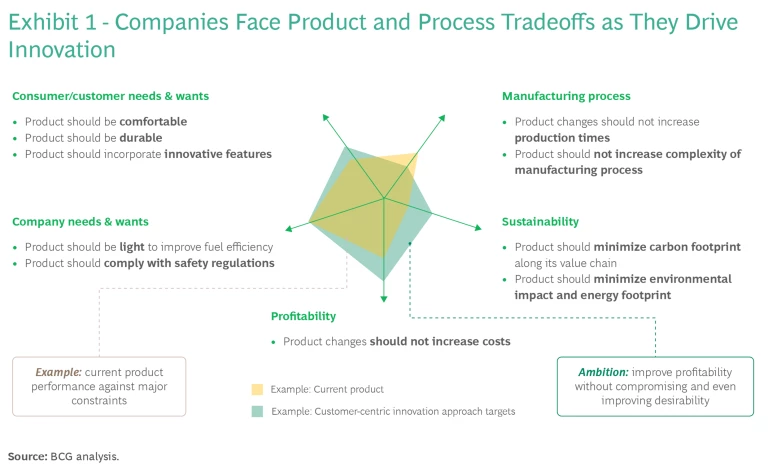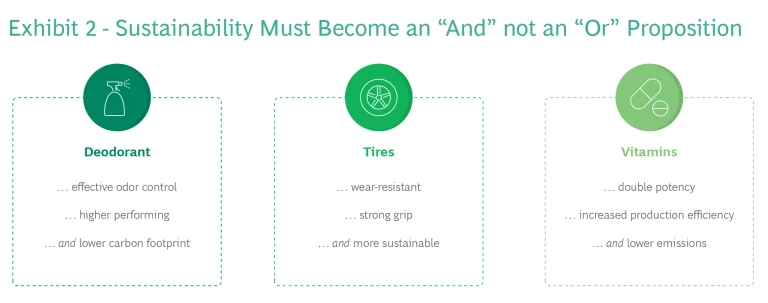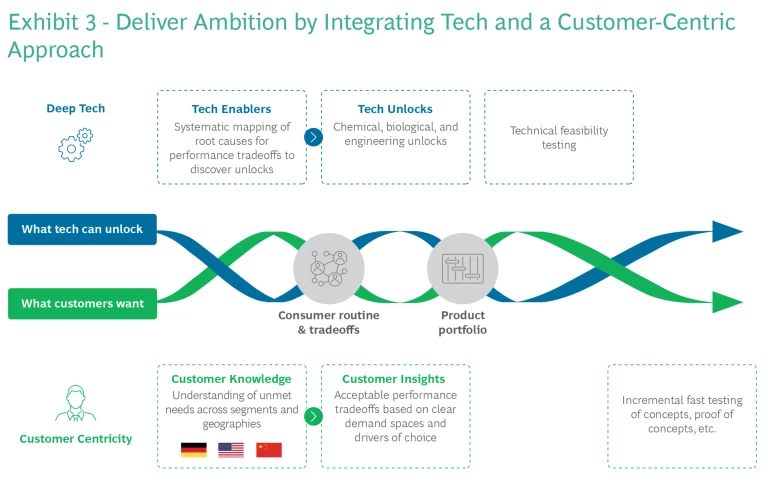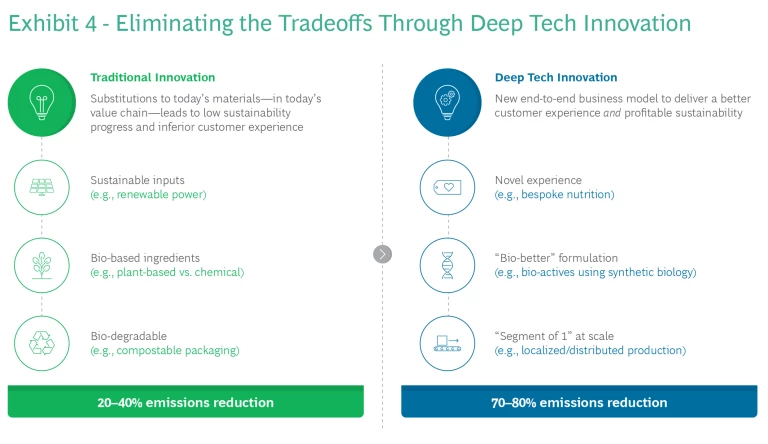Companies are striving to hit ambitious business performance targets while meeting bold 2030 sustainability goals. Yet they face a significant challenge: bridging the gap between rising customer concerns about climate change, pollution, and waste—and the purchasing choices they make when prioritizing core needs such as taste, desirability, or affordability. Part of the problem is that many sustainable products underperform in areas such as cost and quality. Closing this performance gap is essential to achieving both business success and sustainability.
BCG has identified a set of principles that enable companies to eliminate the tradeoffs between sustainability and customer needs, while also enabling companies to increase profitability and manage production constraints. They set out a new approach that brings together marketing and customer intelligence—to gain a full understanding of what customers want and will prioritize—with reimagined processes and deep tech innovation. Deep tech combines new ingredients such as materials produced using synthetic biology with digital technologies such as artificial intelligence and robotics.
Companies that apply these principles can reinvent products that overcome customer barriers to sustainable choices and deliver both environmental and financial gains. (See Exhibit 1.)

On Sustainability, Customers Often “Say” One Thing and “Do” Another
When purchasing a product, customers tend to choose the non-sustainable option despite having concerns about the environment. This reflects what we call the “say-do” gap. As BCG research has identified, this results from barriers to sustainable choices. Customers often assume or find through prior experience that buying sustainable products means compromising on performance. For example, some might have concerns about the range and cost of electric vehicles, while others worry about the effectiveness of sustainable dishwashing detergent. Companies need to activate radical reinvention to reduce the gap between customer sentiment and customer behavior.
Our research has revealed that concern for the environment has not yet become a core driver of customer choice. Recent research we conducted found that in the grocery retail category, 69% of survey respondents expressed concern about sustainability, while only 7% reported buying sustainable products on their last shopping trip. And while the gap is closing, with 23% of customers more recently taking sustainability into consideration when purchasing products, change in their buying behavior is not happening fast enough.
Crafting Solutions that Accommodate All Perspectives
Despite customer hesitance to “buy green,” in our work we have seen many examples of sustainable products across different sectors that save customers money or time and deliver improved performance.
- Unilever has produced a laundry detergent capsule that combines performance (color brightness and longevity) with sustainability (plastic-free packaging and clothes washed in cold water on short cycles, cutting energy use/cost by up to 60%). By positioning performance and sustainability as having equal importance in the product, the company eliminates the tradeoff between the two.
- Arcaea has developed an entirely new approach to deodorant based on microbiome biology that enables the product to be more effective, healthier, and more sustainable by using a biological approach that avoids using chemicals such as masking fragrances and bactericides.
Green innovation is not a short-term initiative intended to serve a specialized sustainability-focused segment of the market. It is a long-term strategy that can be applied to a company’s entire product portfolio, driving growth and business value and increasing companies’ share of markets that scale well beyond niche sustainability segments. For example, launching the Prius enabled Toyota to become an early leader in hybrid vehicle technologies. In 2009, 48% of the 290,000 hybrid cars sold in the US were Priuses.
The Answer to Creating to Profitable, Sustainable Products
We have identified four key principles companies can use when developing new products to fulfill this promise:
- Build a granular understanding of customer needs and how they vary by demand space to inform what is needed for a product to succeed and where tradeoffs can be made for each segment.
- Reimagine processes using “what if” analyses and design questions to move from incremental changes to a new end-to-end business model.
- Deploy deep tech to develop products that offer performance improvements, address emerging customer behaviors and unmet needs, trim in areas that matter less, and achieve scale by cascading innovation and partnering.
- Use an integrated approach that brings together marketing and customer intelligence with deep tech innovation and applies these lenses to find solutions that meet business objectives and sustainability goals.
Through these principles, companies can radically reinvent their approach to products, eliminating performance tradeoffs and shifting mindsets from seeing sustainability as an “or” offering to considering it as an “and” proposition. (See Exhibit 2.) Let’s take a more detailed look at each principle.

Principle One: Understand the customer.
As our research and recent work have shown, radical and successful innovation always starts with the customer. Customers have different emotional and functional needs that vary depending on their demographics, attitudes, and the context in which they buy and consume products. This makes it critical to understand precisely what they prioritize, and when.
In particular, buyers make different tradeoffs in product categories depending on the occasion. For example, in homecare products, families with young children around the house look for safety and protection, while Baby Boomers more often seek convenience and affordability. In food and beverage, people tend to look for healthier morning eating options, while in the afternoons and evenings they seek pleasure and reward. In the cosmetics market, people might be more concerned with a lipstick’s long-lasting color vibrancy for specific occasions than with how sustainable or affordable it is.
To remove tensions between these different needs, companies must take a 360-degree approach to understanding what constitutes value for customers. This will determine what product properties or performance attributes should drive the designs, inputs, and performance tradeoffs of products that can drive growth and business value—while increasing companies’ share of a market that goes far beyond sustainability-focused segments.
To activate this key principle, apply the following tactics:
- Take a systematic approach to link customer demand insights to opportunity screening, which applies feasibility, desirability, and viability as lenses through which to assess potential business ideas from the beginning.
- Scan the external ecosystem for insights, including academia and the venture and startup worlds.
- Examine what constitutes value for customers in individual products and how this varies among different target groups, including assessing what needs are unmet and what is currently over-delivered or can be traded off.
- Use an ongoing feedback loop (not a one-time process) to gain insights on customers.
Principle Two: Reimagine processes.
Since most leading products are already heavily optimized around their current technologies and performance attributes, driving mainstream green demand for sustainable products will not be possible through incremental changes. Nor will careful, methodical processes that minimize risk to the brand proposition. Bolder moves and new ways of working are necessary. Our research and project work has shown that, armed with comprehensive customer intelligence, breakthrough innovations can be developed and scaled systematically to reinvent product portfolios.
For completely new offerings and technology combinations, leverage the granular understanding of customer needs to identify core tradeoffs between sustainability, performance, and profit and make them the focus of “what if” analyses that will provide a clear link to value.
This is the hardest step, but companies have done this before, creating category-defining brands in the process. For example, P&G asked its team, “What if we could develop cleaning products that radically reduced packaging by requiring no plastic bottles, could be manufactured with renewable energy, and also delivered a new and improved customer experience?” The result was the company’s line of EC30 sustainable waterless cleaning products.
For existing products and mature technologies, asking the right design questions can spur thinking and action on new processes. Some questions to consider include:
- Can the company dematerialize by using fewer materials in products or packaging while providing the necessary functionality?
- Can new materials be used to minimize a product’s environmental impact without diminishing its functionality?
- Can new green sourcing—materials, parts, and components that reduce the environmental impact of logistics and production—be embedded in the design?
- Can use of the product’s materials be extended by designing it to facilitate repairs, upgrades, adaptations, multiple uses, or remanufacturing?
- Can product efficiency be increased, reducing its carbon footprint during use?
- How could designing for circularity—allowing for remanufacturing, which requires much less energy—reduce the product’s overall footprint?
Principle Three: Harness the power of deep tech.
Deep tech is driven by combinations of chemistry, engineered biology or advanced materials, and new digital technologies such as AI and robotics/automation. Using these tools, it is possible to develop mainstream green products that meet customer needs and sustainability criteria.
Options are emerging from innovations in enzymes, sustainable chemistry, and synthetic biology that can unlock value when combined with innovative design. For example, biotech company Conagen has used its proprietary fermentation technology to create a version of carminic acid— normally extracted from insects—for use as a red food dye. Conagen’s alternative reduces pressure on traditional supply chains by enabling carminic acid to be produced in large volumes and creates a product that has a lower risk of triggering negative side effects in people who are allergic to insect proteins.
Robotics, automation, and AI can also significantly speed up the discovery, testing, and development of new materials and compounds, in some cases reducing these processes to a matter of days, rather than the months it would take human researchers. For example, Google’s Deep Mind has used an AI tool called GNoME to identify 2.2 million new crystals, including 380,000 stable materials that could be used to develop transformative technologies from next-generation batteries for use in vehicles to superconductors that could power supercomputers.
Deep tech innovation enables companies to turn customer insights into technical unlocks. For example, suppose customer insights suggest that long-lasting makeup is a key selling point. Conventional formulas that deliver this performance at a low cost generally have relied on using non-sustainable petrochemicals. But by delving into the scientific mechanisms of action for the product—such as how ingredients create adhesion to the skin, meet packaging and stability requirements, and can be processed with other ingredients—it is possible to map why there are tradeoffs. Using this understanding, the potential for sustainable bio-based chemistries to deliver adhesion, moisturizing, and other benefits can be assessed and used to develop new product formulas. Once that is accomplished, creating a high-performing, sustainable product is a straightforward process.
To activate this key principle, apply the following tactics:
- Use a root-cause analysis to understand the scientific, engineering, and economic rationale behind these core tradeoffs.
- Identify new technical enablers that can provide more desirable options, going beyond the product to the broader value chain.
- Consider combinations of existing and new technologies to meet redefined product objectives. In particular, consider lateral innovation from outside the company’s industry. Take a systematic make-buy-partner approach to capability building and understand what tools and technologies R&D teams can harness internally and what requires external partnering.
- Create technology platforms (in which technical components can be adapted for use across multiple products) to rapidly reformulate and test product innovations.
- Achieve scale by cascading innovation across the portfolio, taking an agile approach to iterative product improvement grounded in customer insights.
Principle Four: Deploy an integrated approach.
Whether it focuses on product development, marketing strategy, or a company’s mission, radical reinvention is a transformative process that can yield tangible benefits in speed, cost, efficiency, effectiveness, sustainability, and business value. It requires ambitious thinking and an integrated approach, harnessing the capabilities of different business functions and working systematically to bring together customer centricity and deep tech. (See Exhibit 3.)

This approach rarely occurs outside the operations of industry leaders in other sectors such as aviation or auto manufacturing. However, we think it can be applied more broadly by companies that want to drive business and environmental impact by delivering an innovative new portfolio of products, such as consumer goods, fashion and beauty, and durables.
To activate this key principle, apply the following tactics:
- Appoint a program leader responsible for end-to-end development of the product. This leader can marshal the resources of marketing, R&D, finance, and other teams in working together in new ways to reinvent products.
- Embrace long-term thinking that can be applied not just to specialized sustainability-focused segments but to the entire portfolio.
Pulling It All Together
These four principles do not stand alone. Customer understanding, reimagined processes, deep tech, and the integration of different functional teams all work in concert. Collaboration between marketing teams, with their insights and intelligence into customer demand—and R&D teams, with their understanding of what is possible from a technical perspective—is essential to making it all work.
When these principles are activated, the resulting gains in both performance and sustainability are significant. Increases in effectiveness and efficiency can translate into two-to-threefold acceleration in time to market for successful innovation. And marrying customer-centricity with deep tech innovation can de-risk product innovation and dramatically improve the sustainability of new products. From our experience, they can achieve 70% to 80% emissions reductions versus 20% to 40% through traditional innovation—while achieving broad customer coverage, delivering a better customer experience, and meeting the vast majority of customer needs to unlock growth. (See Exhibit 4.)

Aligning customer, corporate, and environmental value is not always easy. But as new technologies expand, opening opportunities for product redesign—and as customers demand sustainable product alternatives that perform well and meet their core needs—hitting the value trifecta is increasingly possible. In particular, companies must seize the potential of renewable energies, synthetic biology, advanced materials and manufacturing, and AI.
Given the urgency of taking action on climate impact and the slow pace of change in customer attitudes toward sustainability, companies need to start transforming the way they innovate now. They must use their granular knowledge of customers to exceed their expectations—and increase demand—by offering products that deliver exceptional performance, superior customer experience, and sustainability.
Companies that succeed will increase their profits and enhance their ability to compete in a tough market. Sustainable innovation can be a way to reinforce core customer needs and drivers of choice while creating iconic brands and experiences that will generate outsized returns for decades to come. In short, what is sustainable for the planet will also deliver long-term business sustainability.
The authors would like to thank Mikael Le Mouellic and Mario Farsky for their input and expertise.






